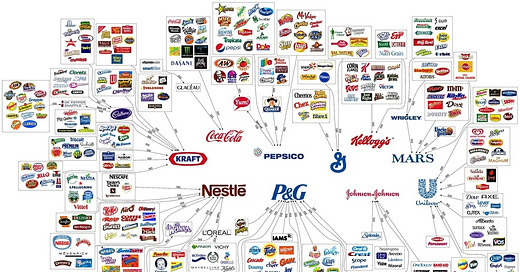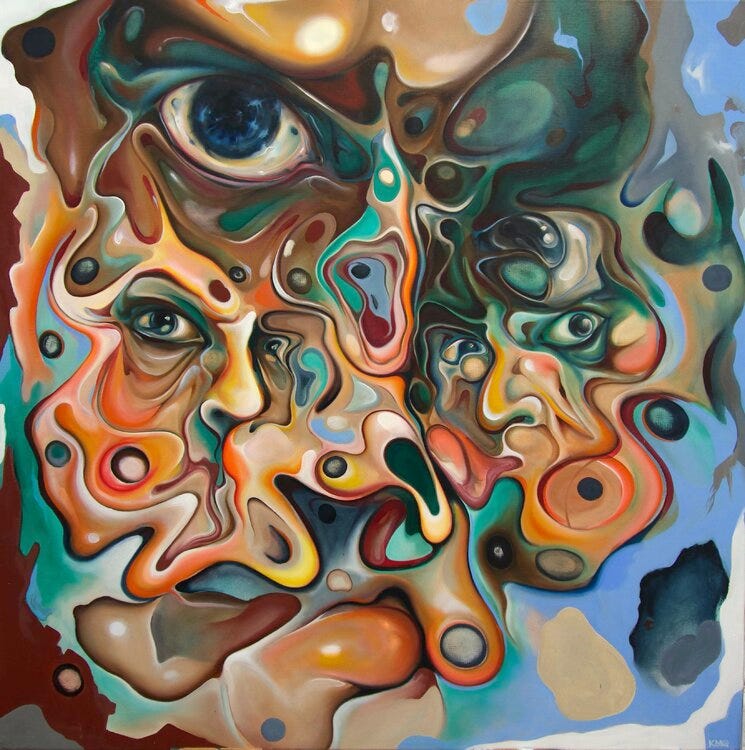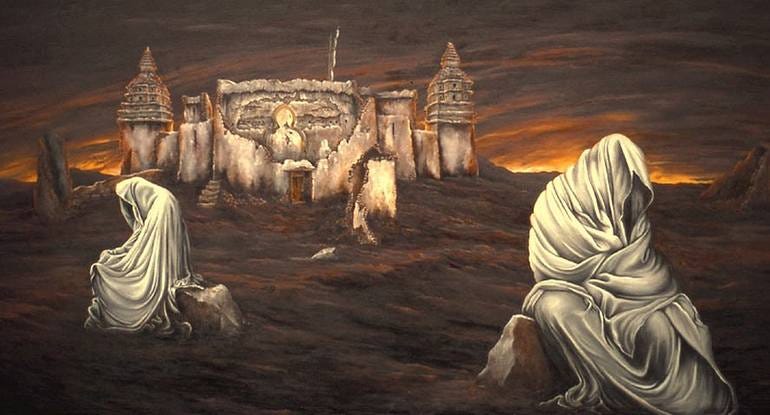Gravity's Rainbow - Part 2 - Chapter 7.1: Murders and Acquisitions
Analysis of Gravity's Rainbow, Part 2 - Chapter 7.1: The Imipolex G Documents and Slothrop's Visit to Nice
Before Slothrop attended Perlimpinpin’s party (Part 2, Chapter 6), he stopped at Hilary Bounce’s teletype (2.5)1 to send for some information on the SG-1 Document and Imipolex G. He did receive the document before the party, but it isn’t until now, afterward, that he opened it up. It turns out that Imipolex G is “a new plastic, an aromatic heterocyclic polymer, developed […] by one L. Jamf for IG Farben” (249) — Jamf being the Pavlovian who was conducting experiments on Slothrop’s genitalia (1.13). The document Slothrop received shows the origins of Imipolex G beginning with DuPont — a company well known for polymerizing substances that led to the development of non-stick coatings on anything from cooking pans to military tanks. These molecules eventually came out to be toxic and carcinogenic (something that DuPont likely knew well before it was public knowledge) and thus were banned. However, synthetic molecules are regulated based on specific structures and molecular formulas, not on similarity or on use alone, so what DuPont did was make minor adjustments in the structure of the molecule thus changing the formula, maintaining their profit, and requiring it to go through another long series of tests and legal processes before once again being banned.2 Likely as well, hiding in their back pockets just waiting for the day that another stream of profit was closed off, was another formula ready to replace the old.
The real movement is not from death to any rebirth. It is from death to death-transfigured. The best you can do is to polymerize a few dead molecules. But polymerization is not resurrection.
(166)
The dead molecules have thus been extracted from the bowels of the Earth, polymerized, sold for profit, all while enabling new forms of death to arise. And, back in the novel, with these new heterocyclic rings at his disposal, Laszlo Jamf polymerized Imipolex G for IG Farben themselves.
Jamf3, at the time he created this plastic for IG Farben, was working for Psychochemie AG (a fictional chemical conglomerate whose name obviously brings to mind the psychochemical/psychopharmaceutical realms of production). To understand what this company was, we need to backtrack to see its origins. Psychochemie AG was “originally known as the Grössli Chemical Corporation” (250)4 which itself was “a spinoff from Sandoz” (a real company) where “the legendary Dr. Hofmann made his important discovery” (250). This discovery was one of the hallucinogenic compounds that would be used to create LSD in the future (a drug that would itself eventually be used, in what is known now as MKUltra, in the 50s and 60s by the CIA to conduct attempts at mind control through the dosing of unaware soldiers and prisoners, which should call to mind The White Visitation’s attempt to control Slothrop). This company, Sandoz, along with Ciba and Geigy (both being Swiss chemical corporations whose work originated in dye manufacturing), merged to form a Swiss chemical cartel which shortly afterward also absorbed Grössli Chemical Corporation. This Swiss cartel formed an agreement with IG Farben who thus created a “cover company in Switzerland, IG Chemie” (250) which finally, after the selling of certain stocks, came to be known as Psychochemie AG.5 Hence why Imipolex G was “cross-filed for both the IG and for Psychochemie” (250).
Hilary Bounce works for Shell Oil though, not IG Farben or Psychochemie AG (though he does wear that necklace . . .), so how does he have access to this information on Imipolex G? Well, ICI6 made an agreement with Shell Oil in 1939 which allowed for Imipolex to market this plastic. Then that begs the question: why would ICI, a British chemical manufacturer, be given the rights to Imipolex G, which is currently owned by IG Farben, a German chemical manufacturer who is in competition with ICI? Two threads can be followed for this. First, IG Farben holds its cover in the Swiss (but not really Swiss) company Psychochemie AG which is assisted by the Swiss cartel. Given most people know that Swiss cartels and banking systems are notorious for holding money for various corporations and individuals around the world, one could only assume that Psychochemie AG also has ties to British corporations. Secondly, Shell is the one mediating this transaction, and Shell, being an oil producer, likely does not see itself as having any borders (as we can see in 2.5 where Slothrop discovers Shell helping both the British and the Germans launch rockets at each other because either way, there will be profit). The final bit of information on these documents ties it all together: Imipolex G, the substance made by Laszlo Jamf for IG Farben, “shows up on a mysterious ‘insulation device’ on a rocket being fired with the help of a transmitter on the roof of the headquarters of Dutch Shell” (251), the same Dutch Shell which Slothrop and Bounce discussed before the party. And the place which is gathering the rocket intelligence that eventually is relayed to Slothrop: well, it must, so Slothrop muses, be Shell Mex House — the British version of Dutch Shell headquarters. It really does seem as if each of these apparently distinct companies and corporations is working together toward the same goal, does it not?
However, as Slothrop imagines himself bravely and violently raiding Shell Mex House in order to find one Duncan Sandys only to find yet another bureaucratic office space, he realizes that figuring out minor pieces of information, such as the titles and names of people running the show, is quite pointless because They are the ones who have set up said titles and names. Questions such as this are only meant to mislead: “If they can get you asking the wrong questions, they don’t have to worry about the answers” (251). So even if Duncan Sandys is who Slothrop thinks he is, this discovery would either lead him nowhere or would even open up more questions that would prove to confuse things further. On top of this, wondering “How high does it go?” (251) does not even make sense when all of this information happens to be tied in a horizontal web as opposed to vertically. Likely, people aren’t even where the focus should lie on, but the system itself which, as Slothrop envisions, is run by machines within offices that once held workers.
Slothrop (now wearing the zoot suit, which could either mean we are looking at him as America to observe the oppression and commodification placed upon him, or that he will be America enacting those ideas) looks one last time at that original parts list that led him to this research to find a last term: “‘S-Gerät, 11/00000’” (252) — likely an extension of SG-1, Gerät meaning device, referring to a device that was made out of Imipolex G, and 00000 being the serial number of the V2 rocket that the S-Gerät was placed into (though, the quintuple zero rocket is something Slothrop has never heard of). Zero has also been a reference to death throughout the novel, reality living on one side and the dead souls on the other, so the quintuple zero has embodied the concept of death many times over — it is more than just individual death, it is the death of the human race. In conclusion, Slothrop’s findings show a mysterious device known as the S-Gerät which was made out of Imipolex G (a synthetic plastic made by Laszlo Jamf for IG Farben) that was placed in a V2 rocket with the serial number 00000.
He continues back into the Casino Hermann Goering where he finds a copy of the London Times sitting at a table, though he does not yet realize the absurdity of a London paper waiting for him in France. The paper contains the obituary of Tantivy Mucker-Maffick, eulogized by Teddy Bloat. As a reminder, Bloat and Mucker-Maffick were the original two men with Slothrop at the casino when Katje was saved, Mucker-Maffick being the one who confided a few too many secrets to Slothrop leading to his disappearance, and Bloat being the one who seemed far too unphased by the disappearance, leading to Slothrop’s distrust of him. Paranoid, or just too aware of what is really going on, Slothrop thus bounces back and forth between possibilities: was Mucker-Maffick killed for revealing too much? are they lying to Slothrop to instill fear in him and to subdue his search a little? or, whether Mucker-Maffick is dead or not, is this information left here to lead Slothrop on yet another quest?
In fact, whether They intended it or not, it does lead him on another quest, though he believes he is escaping. He says a distrustful goodbye to Hilary Bounce (distrustful in that he really cannot figure out who to trust and who to suspect) and heads off to Nice, France, which he gets to by a few other coincidences such as finding “a black Citröen with the keys left in” (253). When he arrives in Nice, he uses the business card which Blodgett Waxwing gave him to find a certain hotel. He passes through the halls until he comes across a maid telling him that he never should have left, that they were only trying to help him. He realizes They are still following him despite his escape, attempting to turn him back to continue the study (possibly trying to make him believe he has finally broken out of their plan by literally telling him to go back), yet Slothrop is fastidious in his goal and presents the business card, forcing the maid to smirk and show him where he wants to go. Slothrop proceeds to meet a series of people who when he provides them with the card from Waxwing, provide him with a place to sleep and a free wad of cash. A few of these men, however, wear Apache sideburns, similar to those that the secret service agent wore as he trailed Slothrop to Perlimpinpin’s party (2.5).
During his night spent in the hotel room, Slothrop is visited by ghosts of his past: some whom we’ve never heard of (Murray Smile), some who we’ve briefly met (Jenny, one of Slothrop’s girls called Jennifer in 1.4, and Dumpster Villard, a friend of his who we met from the trek down the toilet in 1.10) and some who we know quite well (Katje and Tantivy). These visitations signify that his past, that which we know and that which only Slothrop knows, is leaving him behind. As he begins to travel outside of Their control and into the world They created, Slothrop is, in a way, being reborn. His rebirth begins at what They would consider the bottom of the barrel, for he wears the zoot suit and “For possibly the first time he is hearing America as it must sound to a non-American” (256) as the MPs (military police) begin attempting to enter his room. This is a scene that those like the Zoot Suiters were likely used to, police coming to break down their door in the middle of the night, the only evidence proving to be some obscure law being warped to use as probable cause. He sees that, even having been told America was the world’s nonpartisan judge, they play just as unfairly as the “Nazis, and especially [the] Japs” (256).
Slothrop realizes it is his first day Outside (as we will soon see, his first day on his trek to the Zone). His rebirth continues and the identity he has been given by Blodgett Waxwing is “an English war correspondent named Ian Scuffling” (256). The woman who provides him with this name conveys a message from Waxwing as well: that his next stop is Zürich, Switzerland, the home country of Psychochemie AG; he wonders if the only way now is forward, whether by his own free will or by the illusory will that has been bestowed upon him, and if there, just possibly, is any way back.
Up Next: Part 2, Chapter 7.2
Thanks all! Like last week, I posted this one a day early to avoid it landing on a holiday. Hope you all have a great New Year’s Eve and a great New Year as well. Next week I’ll finish up Part 2, Chapter 7. Expect them on Sundays again from now on!
As we get further into the novel, I hope you don’t mind my literal parenthetical references to past chapters. I feel like it takes away from the flow of writing, but I do think it also shows how things tie together better and allows for back referencing. I’ll be shortening these references to just numbers though. So, 2.5 means Part 2, Chapter 5.
For a modern analog to this, think of how modern synthetic drugs (synthetic cannabinoids and synthetic cathinones, for instance) are treated.
Bear with me for a few paragraphs because the connections between all these companies (some fictional, some historically accurate, some a little of both) is tough to decipher, but it is important even if, I would assume for most readers, it doesn’t prove to be the most exciting of reads.
This corporation may be an attempt to reference Grasselli Chemical Corporation which was a chemical manufacturer originating in Cincinnati that at some point merged with DuPont. The Weisenburger Companion seems to say that it “was an actual subsidiary of the IG Farben cartel” (Weisenburger, 133), though I can’t find any sources to confirm this. For now, let’s just look at it as a fictional precursor to Psychochemie AG, which we already know is fictional (in name at least).
Weisenburger, Stephen. A Gravity’s Rainbow Companion: Sources and Contexts for Pynchon’s Novel. 2nd ed., University of Georgia Press, 2006.
I want to stress that everything in this paragraph other than the stuff regarding the Psychochmie AG and possibly Grössli Chemical Corporation actually occurred. None of this is fictional. I also want to thank you for bearing with my attempt at tracing the merging of these companies. Though I hope you realize the absurdity of all this, similar to the dealings between Tamara, Italo, and Co. in the previous chapter (2.6). The point is to show the absurdity in how things like this are so impossibly complex that you can never really get to the root of who is who or what is what and the entire point is to find some way to increase the profits of certain individuals while ensuring their safety from the law as well.
ICI is Imperial Chemical Industries — a British chemical manufacturer who produced chemicals such as dyes, insecticides, and explosives and who also competed with other chemical manufacturers such as IG Farben and DuPont.




![DuPont: The Most Evil Business in the World [24:15] : r/mealtimevideos DuPont: The Most Evil Business in the World [24:15] : r/mealtimevideos](https://substackcdn.com/image/fetch/$s_!mc9_!,w_1456,c_limit,f_auto,q_auto:good,fl_progressive:steep/https%3A%2F%2Fsubstack-post-media.s3.amazonaws.com%2Fpublic%2Fimages%2Ff2b8527f-4758-4c23-a8ea-eccc15034fbf_1280x720.jpeg)


